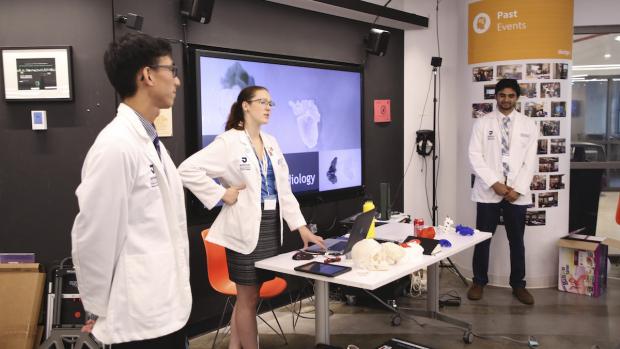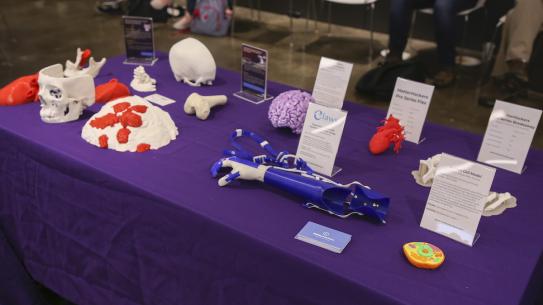NYU Tandon MakerSpace event showcases 3D printing
Inside/Outside Symposium highlights the applications of additive manufacturing in medical and architecture fields

Victoria Bill, the founding manager of NYU Tandon’s MakerSpace, has seen plenty of projects emerge from the facility’s Ultimaker 3D printers. “The ones that are the most impressive to me try to create solutions to pressing real-world problems,” she says. “For example, we have students here at NYU printing custom orthotics for young patients with mobility issues and faculty members addressing the issue of homelessness by designing 3D printed dwellings. There’s an incredible amount of work going on in this sphere that aims to benefit society through the use of rapid prototyping.”
Wanting to find a way to bring attention to the phenomenon, she brainstormed with Matt Griffin, Ultimaker North America’s Director of Community, and his colleague, Education Community Strategist Liz Arum. Together with Christina Lafontaine, the MakerSpace Design Specialist, they came up with the idea of a two-day conference that would showcase the vast possibilities and cutting edge applications of additive manufacturing (as 3D printing is also called, because items are created by adding layer after layer of material) and 3D scanning. Day 1 would focus on applications in the medical field, while day 2 would take architecture as its theme.
The Inside/Outside Symposium, as they dubbed the event, took place on August 8 and 9 and attracted dozens of industry figures and academics to Brooklyn with a high-profile line-up of presenters and a full roster of workshops and demos.
The first keynote was given by Amy Alexander, the Senior Biomedical Engineer at the Mayo Clinic’s Anatomic Modeling Lab, in Minnesota, where she uses advanced medical software to convert 2D radiological imaging data into 3D printed models. She works with surgical teams to digitally plan a patient’s reconstructive surgery in advance, and few attendees were unmoved when she described the case of Abbigail and Isabelle Carlsen, twins conjoined at the liver who were successfully separated in 2006, thanks in part to 3D modeling. (Isabelle, now a teen, has announced her intention of becoming a biomedical engineer.) “3D printing the relevant part in advance of a complex surgery allows for a dry run with an accurately sized model, which can also be shown to patients for more informed consent,” Alexander explained. “Surgeons by their nature have exceptionally strong hand-eye-brain coordination, and this enhances it.”
Equally compelling was day two’s keynote speaker, Melodie Yashar, the co-founder of Space Exploration Architecture (SEArch+), a group devoted to academic space research and practice developing human-supporting concepts for space exploration. In 2015 the organization was awarded the top prize in NASA’s Centennial Challenge for a 3D-Printed habitat suitable for Martian environments. Their 3D printed "Mars Ice House" took into consideration the predicted abundance of water in certain areas on Mars and ice’s ability to filter the sun’s rays and protect against radiation in using the unexpected material. While few attendees may ever have thought about ice as an additive manufacturing material, the resulting structure, enclosed in an inflatable membrane, fired everyone’s imagination of living on the red planet.
While the keynote speakers had connections (of sorts) to Minnesota and Mars, several other presenters hailed from much closer to Brooklyn. “One of the most exciting things about planning the conference was the abundance of experts right here at NYU’s various schools,” Bill said. “We have built a community of engineers, medical practitioners, and designers who are spreading the word about how much can be accomplished with a little outside-of-the-box thinking and some filament.”

NYU speakers included:
- Stacy Kirsch, an occupational therapist from NYU Langone, who spoke about alternative technologies in pediatric rehabilitation
- Lukasz Witek, from the NYU College of Dentistry, whose talk concerned 3D printing strategies for the reconstruction of boney defects
- Pamela Cabahug-Zuckerman of Langone and Tandon, who discussed bone micro-architecture in pre-clinical research using micro-CT
- Amy Hurst of Steinhardt, Tandon, and the NYU Ability Project, with a presentation on how additive manufacturing can advance accessibility and adaptive technology
- Louise Harpman of NYU Gallatin, who discussed architecture, design, and her Zero House, a self-sufficient, pre-fabricated micro dwelling that is solar-powered, collects its own water, and processes its own waste




